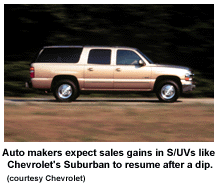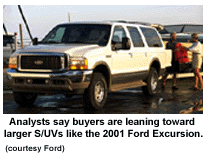|
S.O.S. for S/UVs?
|
 |
September 26, 2000: 12:07 a.m. ET
S/UV growth has slowed, but experts credit gas costs, not the recall effect
By Staff Writer Alex Frew McMillan
|
NEW YORK (CNNfn) - Does the Firestone-Ford tire recall toll the death knell for sport/utility vehicles? Not at all, car industry analysts say.
But the huge popularity of midsize S/UVs like the Ford Explorer is tempering in the face of other pressures such as high gasoline prices and higher interest rates.
"It's been a year-long phenomenon of moderating growth," said Paul Taylor, chief economist of the National Automobile Dealers Association. "That was the fastest growing category last year."
An unsustainable rate of sales
So far this year, almost one in five new passenger vehicles sold in the United States has been an S/UV. That demand peaked in February, according to NADA's figures, when new-car sales, including trucks and S/UVs, hit an annual pace of 19.2 million vehicles.
"That was clearly unsustainable," Taylor said. The stock market was peaking, annual bonuses had just been paid and the impact of three interest-rate hikes this year had yet to come home to roost with consumers.
 The growth has slowed, and new-vehicle sales are now on track to hit 17 million for 2000. But that will still set a new record, as did last year's sales of 16.9 million vehicles. The growth has slowed, and new-vehicle sales are now on track to hit 17 million for 2000. But that will still set a new record, as did last year's sales of 16.9 million vehicles.
Ford S/UV sales fell 8.6 percent for the three months through August, compared with the same period last year. But Chevrolet's S/UV sales also dipped, by 5.5 percent.
"You need to bear in mind that for the rest of the year, you are likely to see some tapering off," said Gwen Knapp, sales spokeswoman for General Motors, which includes Chevrolet. 2000, with its strong first six months, has been a reverse of 1999, when sales closed strongly.
"It's almost as if you can only come down from those numbers," Knapp said. GM is "inventory constrained" on a number of new models, she said - meaning it can't make enough. "The industry can't sustain those sales."
"Accidents happen -- to someone else"
That many new Explorers came with the now-recalled Firestone tires, coupled with speculation that the Explorer's design causes it to topple over in a blowout, cannot help the brand. But it does not appear to be hurting it that much, either.
 "Rollover risk has been known for a long time, and it hasn't hurt S/UV sales," said David Bradley, auto analyst for J.P. Morgan. "Everyone always assumes that an accident will happen to someone else and not to them." "Rollover risk has been known for a long time, and it hasn't hurt S/UV sales," said David Bradley, auto analyst for J.P. Morgan. "Everyone always assumes that an accident will happen to someone else and not to them."
"The proof of the pudding is that the Ford Explorer has seen virtually no decline in August," Bradley said.
But if questions surrounding tire blowouts and rollover drag on, the reputation of all S/UVs may suffer, according to Knapp at GM.
"If the leaders [of Ford and Firestone] really, really work hard to bring closure, then maybe the sector will not be questioned over time," she said. Consumers "want closure. They want some answers."
S/UVs to dominate sales by middle of decade
Still, lifestyle issues will guarantee that S/UVs become the top-selling class of vehicle by the middle of this decade, GM predicts. S/UVs are currently outsold only by midsize cars and, narrowly, by light trucks.
Explorers still cornered 5.5 percent of the new-car market in August. That's down slightly from the 5.7 percent Explorers claimed in July and down 0.8 percent year-over-year for the month. August sales were also down from July, according to NADA.
 Ford stopped supplying Explorers to dealers for around three weeks after cutting production late last month, to free up tires once the recall was announced at the start of August. Because dealers normally have two months' inventory, Explorer sales may dip in October and November, Bradley said. Ford stopped supplying Explorers to dealers for around three weeks after cutting production late last month, to free up tires once the recall was announced at the start of August. Because dealers normally have two months' inventory, Explorer sales may dip in October and November, Bradley said.
But sales might then rebound, as consumers who have been waiting for an Explorer buy near the end of the year. Any negative fallout from the recall is likely to last a matter of months, analysts said.
Other S/UVs were already catching on
Besides, the recall pales in comparison to other factors in determining what consumers buy.
"Demand for the vehicles doesn't really go away," said Scott Smith, president of Charlotte, N.C.-based Sonic Automotive, which owns 172 new-car franchises, including Ford and competing dealerships. "It shifts."
Typically demand stays with the same manufacturer. "If you're a GM fan, you stick with GM, and the same thing with Ford or one of the other manufacturers," Smith said. Explorer buyers at Sonic's dealerships either haven't cared about the recall, he said, or they have requested a different set of tires.
 New-vehicle buyers were already shifting their focus away from the midsize S/UVs like the Explorer, the Jeep Cherokee and Chevrolet's competing Blazer, according to Bradley and new-car dealers. New-vehicle buyers were already shifting their focus away from the midsize S/UVs like the Explorer, the Jeep Cherokee and Chevrolet's competing Blazer, according to Bradley and new-car dealers.
Richard Kashey, Chevrolet sales manager for San Diego-based City Chevrolet-Volkswagen, said "a couple" of customers have mentioned that the recall put them off buying an Explorer.
But he had noticed that S/UV buyers were already looking to buy bigger S/UVs like the Chevy Tahoe and the Chevy Suburban. Those vehicles compete with Ford's Expedition and Excursion, not the Explorer. Kashey said he imagined sales in those Ford vehicles were increasing, too.
Two new types of niche player
So customers are still buying S/UVs -- just different styles. The growth is both in the premium, oversize S/UVs like the Suburban and Lincoln Navigator and in the small, car-like S/UVs such as the Toyota RAV4 and the Honda CRV, Bradley said. Dealers agreed.
 Price and style is much more important in determining what consumers are looking for, this summer's events suggest. Price and style is much more important in determining what consumers are looking for, this summer's events suggest.
For instance, Rick Watson, sales manager at Momentum BMW in Houston, said a few customers have asked what tires come on BMW's new S/UV, the X5.
But no customers have said they are buying an X5 instead of an Explorer, he said. He attributed that to the fact that the X5 costs over $10,000 more, so it attracts a different buyer.
Small cars are the success story of summer
Rising fuel costs, the byproduct of surging crude oil prices, and higher interest rates have had a serious impact on S/UV sales too, Taylor says. He points out that S/UV sales were hammered in the Midwest this summer - as gas prices there at times rose above $2.40 a gallon. Gas is now averaging around $1.50 a gallon nationwide.
Because S/UVs guzzle gas, "it's the same effect as having a consumption tax," the economist said. But the same factor has hit high-end luxury vehicles, midsize cars and pickups, too. In fact the only vehicle category where sales have held up this summer has been small cars.
Small cars consume less gas. The last time gas prices rose significantly, in 1997, small-car sales also picked up, Taylor says.
But small cars are also cheaper. That is important when the stock market is moving sideways and the cost of borrowing has gone up. Price competition is very strong in small cars, too, Taylor points out, as several Korean car makers like Hyundai introduce new products.
Taylor added that, after three strong years of new-vehicle sales, he suspects the American car-buying public may be "overbought." There are only so many S/UVs, or cars, that Americans need.
So if a drop in Explorer or S/UV sales comes, it will be short-lived and hard to read, experts say.
"On my scale of 1 to 100, If a regular car is a 25, S/UVs are at a 100. This knocks them to a 95," Bradley said. "They're still very popular vehicles. If they're slightly less popular, the impact is still relatively small. You're not going to see people switching back to cars all of a sudden." 
-- Click here to send e-mail to Alex Frew McMillan
|
|
|
|
|
 |

|

